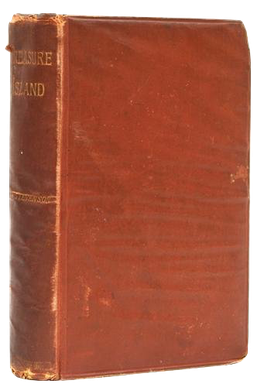This article needs additional citations for verification .(April 2018) |
This list of fictional countries groups fictional countries and imagined nations together, by the region of the world in which they are supposed to be located.
This article needs additional citations for verification .(April 2018) |
This list of fictional countries groups fictional countries and imagined nations together, by the region of the world in which they are supposed to be located.
Dreamland or Dream Land may refer to:
A pirate is a person who commits acts of piracy at sea without the authorization of any nation.

Treasure Island is an adventure novel by Scottish author Robert Louis Stevenson, telling a story of "buccaneers and buried gold". It is considered a coming-of-age story and is noted for its atmosphere, characters, and action.

Pirates of the Caribbean is a dark ride at Disneyland, Walt Disney World's Magic Kingdom, Tokyo Disneyland, Disneyland Park at Disneyland Paris, and Shanghai Disneyland.

The Greater Antilles is a grouping of the larger islands in the Caribbean Sea, including Cuba, Hispaniola, Puerto Rico, Jamaica, Navassa Island, and the Cayman Islands. Six island states share the region of the Greater Antilles, with Haiti and the Dominican Republic sharing the island of Hispaniola. Together with the Lesser Antilles, they make up the Antilles, which along with the Lucayan Archipelago, form the West Indies.
Captain Hector Barbossa is a fictional character of the Pirates of the Caribbean franchise, appearing in all five films in the series. He appears as the main antagonist of the first film, a posthumous character of the second film, a supporting character of the third film and one of the two protagonists of the fourth and fifth films. Starting out as a villainous undead skeleton in The Curse of the Black Pearl (2003), Barbossa dies at the end of the film. However, the character is revealed to have been resurrected and brought back from the dead by Tia Dalma by the end of Dead Man's Chest, and has since appeared in anti-heroic roles. Captain Hector Barbossa was one of the nine Pirate Lords in At World's End (2007), a privateer in service to King George II and the British Navy while also seeking revenge against Blackbeard in On Stranger Tides (2011), as well as a rich rogue and influential leader of a prosperous pirate empire and fleet in Dead Men Tell No Tales (2017). Throughout the series, Barbossa has been conceptualized as a "dark trickster" and the evil counterpart of Captain Jack Sparrow.
Zanzibar is an autonomous part of Tanzania.
Bongo may refer to:

In science fiction, floating cities and islands are a common trope, which range from cities and islands that float on water to ones that float in the atmosphere of a planet by purported scientific technologies or by magical means. While very large floating structures have been constructed or proposed in real life, aerial cities and islands remain in the realm of fiction.
Pirates of the Caribbean is a Disney media franchise encompassing numerous theme park rides, a series of films, and spin-off novels, as well as a number of related video games and other media publications. The franchise originated with Walt Disney's theme park ride of the same name, which opened at Disneyland in 1967 and was one of the last Disneyland attractions overseen by Walt Disney. Disney based the ride on pirate legends, folklore and novels, such as those by Italian writer Emilio Salgari.

In English-speaking popular culture, the modern pirate stereotype owes its attributes mostly to the imagined tradition of the 18th-century Caribbean pirate sailing off the Spanish Main and to such celebrated 20th-century depictions as Captain Hook and his crew in the theatrical and film versions of J. M. Barrie's children's book Peter Pan, Robert Newton's portrayal of Long John Silver in the 1950 film adaptation of the Robert Louis Stevenson novel Treasure Island, and various adaptations of the Middle Eastern pirate, Sinbad the Sailor. In these and countless other books, films, and legends, pirates are portrayed as "swashbucklers" and "plunderers". They are shown on ships, often wearing eyepatches or peg legs, having a parrot perched on their shoulder, speaking in a West Country accent, and saying phrases like "Arr, matey" and "Avast, me hearty". Pirates have retained their image through pirate-themed tourist attractions, film, toys, books and plays.

The cultural influence of Gulliver's Travels has spanned centuries.